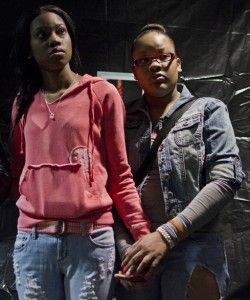Tunnel of Oppression offers perspective on hardships

February 21, 2012
As a group of students walked into a room, they were divided between “dark-skinned” and “light-skinned.” One girl stepped toward the left side of the room, when she was stopped.
“Oh no, no. You’re not light-skinned,” she was told. “You’re going to be dark-skinned today, baby girl.”
Separation based on skin color was just one thing attendees experienced during the “Tunnel of Oppression” Monday night opening, which was organized by the Black Togetherness Organization and University Housing at Grinnell Hall. The
Advertisement
almost hour-long tour of rooms, creating a tunnel, was designed to present different ways people experience oppression.
Each of the 14 rooms on the walk through the tunnel included a different scenario. Some included short videos, while others featured volunteers acting out situations.
In one room, a man in a wheelchair yelled at attendees for the grief he has experienced from not being able to walk.
“The next time your girl wants to go out to a real nice dinner and you won’t take her, you remember my face,” he said. “Because I can’t take my girl out.”
Some aspects of the tunnel encouraged audience participation. In another room, an actor asked attendees to line up as close as possible. This, she said, was the condition people were in for six to eight weeks when they were brought to the United States on ships, only to become enslaved upon arrival.
In one room, where attendees first walked in to find a chalk outline on the floor, the speaker pointed out that homicide is the No. 1 cause of death among young black males. She asked the only black male in the room to look in a mirror.
“This could be your memorial,” she said.
Advertisement*
As participants made their way from room to room, often being yelled at to leave and pushed to the next setting, some cried. At times, some people laughed.
The purpose of the tunnel, organizer Alfred Jackson said, was not to get any certain response form attendees but to simply get reactions.
“Each group is always different, because each thing is individualized,” said Jackson, the program coordinator for University Housing. “Your response, your reaction is always based upon your own background.”
Jackson, who has worked with the event for the past six years, said before the Tunnel of Oppression there was a similar event called Boxes and Walls, where attendees could come and go as they wanted. When he became involved, he said, that changed.
“It was a consensus that we needed a more interactive piece to make people get out of their norm,” he said. “Now, you have to go through everything. You can’t just stop and leave where you feel comfortable at.”
Jackson said he has seen many different reactions in the tunnel.
“We’ve had one young man break out and try to put his fist through a brick wall,” he said. “The reaction — it varies. It runs the whole gamut … it can get intense.”
Because the goal of the event is to get reactions, counselors from the Student Wellness Center wait at the end of the tunnel ready to assist participants.
As part of the event, the group of up to 20 participants engage in a “debriefing” discussion.
After one session Monday, students who have been affected by violence, disability and racism shared their stories in reaction to the tunnel.
Jacqueline Robinson, a freshmen from Chicago studying forensic psychology, said every room affected her in some way.
“It just teaches you to appreciate the things we have done and to appreciate others,” she said. “They were all real-life experiences, things people go through on a day-to-day basis. You see these type of people everyday, and the things they talked about, it goes on every day.”
Robinson said one room that stood out to her was where actors lined students up against the wall and pointed out the difference in skin color among those in the room, separating those on ‘Team Light Skin’ or ‘Team Dark Skin.’
“With the ‘Team Light Skin’, this generation is so caught up with it,” she said. “People like me who have experienced stuff like that, it’s just a wake-up call.”
For volunteers who often give multiple tours a night, the tunnel may lose some impact. Still, volunteer Arnae Calvin, a sophomore from Chicago studying criminology and criminal justice, said she understands what the new attendees go through.
“I like what the Tunnel of Oppression stands for,” she said. “It’s basically to get people aware of what they’re doing that’s unconscious. I do it just because it makes people aware of what they do that hurts other people.”
Calvin, in her second year of working at the tunnel, said she reacted strongly to the event her first time through.
“I cried a lot,” she said. “It’s very emotional, especially if you see yourself in any of these rooms or anything that you go through on a daily basis.”
As a volunteer, Calvin said she hopes others gain as much from the event as she did.
“I just hope that they learn how to change themselves in a good way,” she said.
Advertisement







